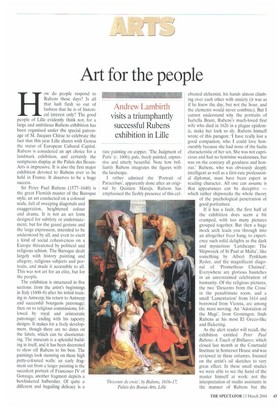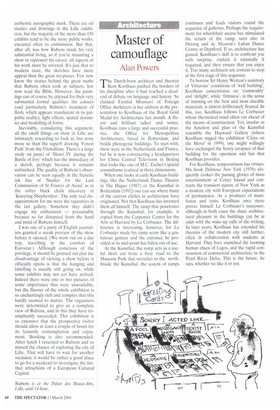Art for the people
Andrew Lamb irth visits a triumphantly successful Rubens exhibition in Lille
How do people respond to Rubens these days? Is all that lush flesh so out of fashion that he is of historical interest only? The good people of Lille evidently think not, for a
large and ambitious Rubens exhibition has been organised under the special patron age of NI. Jacques Chirac to celebrate the fact that this year Lille shares with Genoa the status of European Cultural Capital.
Rubens is considered an apt choice for a landmark exhibition, and certainly the sumptuous display at the Palais des Beaux Arts is impressive. It is also the first major exhibition devoted to Rubens ever to be held in France. It deserves to be a huge success.
Sir Peter Paul Rubens (1577-1640) is the great Flemish master of the Baroque style, an art conducted on a colossal scale, full of sweeping diagonals and exaggeration, heightened colour and drama. It is not an art form designed for subtlety or understatement, but for the grand gesture and the large expression, intended to be understood by all, and even to exert a kind of social cohesiveness on a Europe threatened by political and religious schism. The Baroque dealt largely with history painting and allegory, religious subjects and portraits, and made it accessible to all. This was not art for an elite, but for the people.
The exhibition is structured in five sections: from the artist's beginnings in Italy (1600-8) after his initial training in Antwerp; his return to Antwerp and successful bourgeois patronage; then on to religious commissions; followed by royal and aristocratic patronage; ending with his tapestry designs. It makes for a lively development, though there are no dates on the labels, which can be disorientating. The museum is a splendid building in itself, and it has been decorated to show off Rubens to his best. The paintings look stunning on these high putty-coloured walls: an early fragment cut from a larger painting is the succulent portrait of Francesco IV of Gonzaga, another fragment depicts a bewhiskered halberdier. Of quite a different and beguiling delicacy is a rare painting on copper, 'The Judgment of Paris' (c. 1606), pale, freely painted, expressive and utterly beautiful. Note how brilliantly Rubens integrates the figures with the landscape.
I rather admired the 'Portrait of Paracelsus', apparently done after an original by Quinten Matsijs. Rubens has emphasised the fleshly presence of this cel
ebrated alchemist, his hands almost climbing over each other with anxiety (it was as if he knew the day, but not the hour, and the elements would never combine). But I cannot understand why the portraits of Isabella Brant, Rubens's much-loved first wife who died in 1626 in a plague epidemic, make her look so sly. Rubens himself wrote of this paragon: 'I have really lost a good companion, who I could love honourably because she had none of the faults characteristic of her sex. She was not capricious and had no feminine weaknesses, but was on the contrary all goodness and honour.' Rubens, who was obviously deeply intelligent as well as a first-rate professional diplomat, must have been expert at reading character. All one can assume is that appearances can be deceptive — which rather shipwrecks the whole theory of the psychological penetration of good portraiture.
If it has a fault, the first half of the exhibition does seem a bit cramped, with too many pictures grouped together. But then a huge mock arch leads you through into an altogether freer hang, to experience such solid delights as the dark and mysterious 'Landscape: The Shipwreck of St Paul at Malta', like something by Albert Pynkham Ryder, and the magnificent diagonal of 'Prometheus Chained'. Everywhere are glorious haunches in an unrestrained celebration of humanity. Of the religious pictures, the two 'Descents from the Cross' in the penultimate room, and a small 'Lamentation' from 1614 and borrowed from Vienna, are among the most moving. An 'Adoration of the Magi', from Groningen, finds Rubens at his most El Greco-like and flickering.
As the alert reader will recall, the exhibition entitled Peter Paul Rubens: A Touch of Brilliance, which closed last month at the Courtauld Institute in Somerset House and was reviewed in these columns, focused on the artist's oil sketches to very great effect. In these small studies we were able to see the hand of the master himself at work: not the interpretation of studio assistants in the manner of Rubens but the authentic autographic mark. There are oil studies and drawings in the Lille exhibition, but the majority of the more than 150 exhibits tend to be the more public works, executed often to commission. But that, after all, was how Rubens made his very substantial living, so if you're mounting a show to represent his career, all aspects of his work must be covered. It's just that to modern taste, the sketches have more appeal than the great set-pieces. Few now know the stories behind the great myths that Rubens often took as subjects, few now read the Bible. However, the paintings can of course be enjoyed for their very substantial formal qualities: the colours (and particularly Ruberis's treatment of flesh, which appears translucent in its palpable reality), light effects, spatial dynamics and modelling of forms.
Inevitably, considering this argument, all the small things on show in Lille are intimately rewarding to look at, but none more so than the superb drawing 'Forest Path' from the Fitzwilliam. There's a large study on panel of 'Henri IV during the Battle of Ivry' which has the immediacy of a sketch, perhaps because it remains unfinished. The quality of Rubens's observation can be seen equally in the frenetic ink line of 'Studies for the Last Communion of St Francis of Assisi' as in the softer black chalk discovery of 'Kneeling Shepherdess'. The only real disappointment for me were the tapestries in the last gallery. Somehow they didn't engage my enthusiasm — presumably because so far distanced from the hand and mind of Rubens himself.
I was one of a party of English journalists granted a sneak preview of the show before it opened. (We went out on a day trip, travelling in the comfort of Eurostar.) Although conscious of the privilege, it should be pointed out that the disadvantage of viewing a show before it officially opens is that the hanging and labelling is usually still going on, while some exhibits may not yet have arrived. Indeed there were one or two pictures of some importance that were unavailable, but the flavour of the whole exhibition is so enchantingly rich and complex that this hardly seemed to matter. The organisers were determined to give us a complete view of Rubens, and in this they have triumphantly succeeded. This exhibition is so extensive that the prospective visitor should allow at least a couple of hours for its leisurely contemplation and enjoyment. Booking is also recommended. After lunch I returned to Rubens and so missed the chance of exploring the city of Lille. That will have to wait for another occasion; it would be rather a good place to go for a weekend to investigate the further attractions of a European Cultural Capital.



































































 Previous page
Previous page